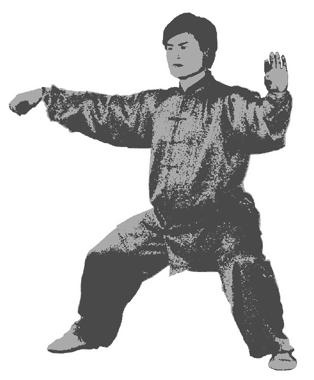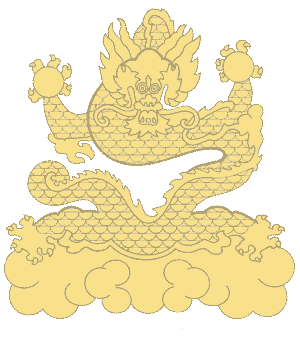The Six Stages of Training
It is said that training in Chenstyle taijiquan is divided into six
stages:
1. Learning Form (xue jiazi) This stage covers learning Chansi gong
exercises, basic stances, hand formations, footwork, and then learning
Taolu.
2. Correcting Form (zheng jiazi) In this stage, postural requirements
are emphasized, and obvious errors in the form are corrected.
3.Adjusting Form (nie jiazi) At this stage, meticulous care is taken
to ensure that the final form of each posture is correct, with the
student holding the individual postures statically for a period of
time.
4.Smoothing Form (shun jiazi) In this stage, the student works to
connect the individual postures smoothly and with internal energy
throughout the movements.
5. Breaking Down Form (chai jiazi) This stage emphasizes the combat
application of each movement in the form. The student learns how to
use each posture in combat, and adapt it to changing circumstances.
The student devotes more time to pushing hands practice, and begins
free sparring.
6. Settling Form (ding jiazi) In this final stage, the form settles
into a coherent whole, integrating knowledge gained in previous levels.
At this point, the student begins to train to increase body strength
with auxilliary training exercises, and further develop combart ability
through dual training exercises.
The Levels of Skill
Accomplishment in Chen style Taijiquan is measured by levels. There
are five levels of accomplishment:
1. Structure and Strength
This basic level encompasses basic postural requirements (shen fa)
movements of the routines (choreography- zi shi) and structure of
the movements (jia shi). At this level, the student builds leg strength
and ability to relax the body, avoiding stiffness.
This level may begin with standing exercises, then progress to Chansi
Gong, and then to Tao lu. Some teachers begin with Taolu, adding standing
and Chanssu gong at a later time, depending on the student’s
ability.
As one becomes more comfortable with the movements, and the body
becomes stronger and more relaxed, one begins to experience the circulation
of nei qi in the body as a result of ones practice and develop the
fundamental jin (energy) of peng. The student may gradually feel the
circulation of internal force in the torso and limbs, but will not
be able to direct it to various parts of the body at will.
In the first level of kung fu, one’s mind and concentration
are mainly on learning and mastering of the external forms of taijiquan.
2. Technique
The second level of kung fu involves further reducing shortcomings
such as: stiff force produced while practising taijiquan and the incorrect
application of force. Effort is made toward coordinating movements.
With diligent effort, the student will eventually achieve a coordination
of internal energy with external movement. The student works toward
further refinement and correction of his posture.
As the postural requirements are smoothed out so that the various
parts of the body move in unison, the student begins to develop the
“three harmonies” (wai san he). This refers to coordination
of external body parts: the coordination of hands with legs, elbows
with knees, and shoulders with hips.
At this point in training, the student will begin to feel heat throughout
the body as they begin to cultivate qi.
At this level, the student will concentrate on coordinating the movements
of limbs and body and coordinating internal and external movements.
He will develop the ability to adjust his body to ensure a smooth
flow of the internal energy, furthering his proficiency in and understanding
of Chanssu jing.
3. External Energy
In the third level, the student’s movements are coordinated,
his posture correct, and his internal energy circulates well. At this
level, while the student’s movements appear “soft’
they have the potential for manifestation of strong internal energy.
He is conversant enough with the movements to be able to correct himself
while practicing.
In the third level, the student is introduced to the concept of “reverse
breathing” in order to perfectly coordinate external movements
with the intake and exhalation of breath. The student is at this point
developing a solid “root”, or strong ability to stand
firmly.
Along with an understanding of the combat applications of the individual
postures contained in Taolu, the student is developing the ability
to dissolve (zouhua) an opponents attack thru practice of pushing
hands, and begins to develop the ability to issue force (fa jing)
thru the practice of individual postures from Taolu and auxiliary
exercises such as Dou Gunzi (shaking a long pole).
4. Intrinsic Energy
This is regarded as a high level of kung fu.
At this level, the student should have mastered the method of training.
He should understand the important aspects of each movement in the
forms, and be able to understand the combat application of each movement.
He should have a smooth flow of internal energy , and have complete
coordination of his movements with his breathing. He should be proficient
with the dissolving of force, and perfect his ability to issue force.
At this point, during the performance of Taolu, the practitioner
exhibits what has been termed “a sense of the enemy”;
executing the movements as though actually fighting with opponents.
As Chen Xiaowang has stated, “At this level you have enough
familiarity with all the techniques and applications, to a point where
conscious effort is not necessary. When you do the set, it seems like
you are fighting an invisible opponent.”
5. Spirit
At this level, one is said to have internalized all of the qualities
of taiji quan. To quote Chen Xiaowang, “This state refers not
just to performing the set or to the application of technique, but
to all your activities, whether you are sleeping, walking, etc....Every
move and every motionless instant is in accordance with taiji principle,
as are the movements of the whole body. This means that every part
of the body should be very sensitive and quick to react when the need
arises. So much so that every part of the body can act as a fist to
attack whenever is in contact with the opponent’s body.
Therefore the description for this level of kung fu is that it is
the ‘only one that plays with 50% yin and 50% yang, without
any bias towards yin or yang, and the person who can do this is termed
a good master. A good master makes every move according to the taiji
principles which demands that every move be invisible.’
Among the principles of Chen Taijiquan which a fifth level practitioner
expresses:
The Internal drives the External
The Yi leads the Qi
Opening and Closing
Reeling silk Energy
Whole Body Movement
Harmony of Internal and External
Continuous Movement
Harmony of Soft and Hard
Harmony of Fast and Slow
|



